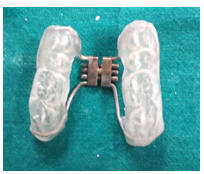Comparison of Equivalency of Volumetric Expansion Between Nasopharynx and Oropharynx in Patients with Class II Malocclusion Subjected to Rapid Maxillary Expansion using Cone Beam Computed Tomography – A Prospective Study.
Main Article Content
Abstract
Objective: The purpose of this study is to analyse the change in the total volume of the oropharynx and nasopharynx after the maxillary expansion done with HYRAX (Hygienic Rapid Expander) and its proportionality with each other. Materials and method: 20 patients were selected for the study. Midline diastema, intermolar width, the volumetric change in the nasopharyngeal and oropharyngeal airway, and McNamara Airway analysis to measure the airway was measured on CBCT Scans before and after expansion. We have evaluated some angular measurements such as saddle angle, articular angle and the gonial angle to evaluate changes in the position of the mandible. Results: Results of paired t-test showed the volume of the nasopharynx has increased with a mean of -3.0200±1.46; p-value =0.001. The volume of the oropharynx has increased with a mean of -7.7600±5.082; p-value =0.001. Increase in the nasal width with mean of -2.0800±0.71642; p-value =0.001. Increase in the intermolar width mean of -4.86000±1.694; p-value = 0.001. McNamara analysis done for upper and lower pharyngeal airways with mean = -1.80100±0.713 p-value = 0.001, mean = -2.37000±0.857 p-value = 0.001 for upper and lower pharyngeal airway respectively. The saddle angle shows a significant reduction with the mean= 3.1000±2.22 p-value=0.001. Articular angle shows an increase (p=0.001) with a mean difference of 3.500±2.60. The Gonial angle decreased with the mean difference=2.40±1.3 p= 0.001. Conclusion: Use of RME results in increase in the volume of oropharynx and nasopharynx, nasal cavity width and the intermolar width which was statistically significant too.
Article Details
References
El H, Palomo JM. Three-dimensional evaluation of upper airway following rapid maxillary expansion. A CBCT study. Angle Orthod. 2014; 84:265-273.
Aloufi F, Preston CB, Zawawi KH. Changes in the upper and lower pharyngeal airway spaces associated with rapid maxillary expansion. ISRN Dent. 2012; 290964:1-5.
Timms DJ. The dawn of rapid maxillary expansion. Angle Orthod. 1999; 69:247-250.
Hershey HG, Stewart BL, Warren DW. Changes in nasal resistance associated with rapid maxillary expansion. Am J Orthod. 1976; 69:274-84.
Cunha Ribeiro AN, De Paiva JB, Neto JR, Filho EI, et all. Upper airway expansion after rapid maxillary expansion evaluated with cone-beam computed tomography. Angle Orthod. 2012; 82:458-463.
Christie KF, Boucher N, Chung CH. Effects of bonded rapid palatal expansion on the transverse dimensions of the maxilla: A cone-beam computed tomography study. Am J Orthod Dentofacial Orthop 2010;137: S79-85.
Oliveira De Felippe NL, Da Silveira AC, Viana G, Kusnoto B, Smith B, Evans CA. Relationship between rapid maxillary expansion and nasal cavity size and airway resistance: Short and Long-term effects. Am J Orthod Dentofacial Orthop 2008; 134:370-82.
Baratieri C, Nojima LI, Alves M Jr, et all. Transverse effects of rapid maxillary expansion in Class II malocclusion patients: A Cone-Beam Computed Tomography study. Dental Press J Orthod. 2010; 15:89-97.1
Izuka EN, Neuppmann Feres MF, Nagata Pignatari SS. Immediate impact of rapid maxillary expansion on upper airway dimensions and on the quality of life of mouth breathers. Dental Press J Orthod. 2015; 20:43-9.
Palaisa J, Ngan P, Martin C, Razmus T. Use of conventional tomography to evaluate changes in the nasal cavity with rapid palatal expansion. Am J Orthod Dentofacial Orthop 2007; 132:458-66.
Zeng J, Gao X. A prospective CBCT study of upper airway changes after rapid maxillary expansion. International Journal of Paediatric Otorhinolaryngology. 2 013; 77:1805-1810.
El Hakan, Palomo JM. Three-dimensional evaluation of upper airway following rapid maxillary expansion. A CBCT study. Angle Orthod. 2014; 84:265-273.
El Hakan, Palomo JM. Measuring the airway in 3 dimensions: A reliability and accuracy study. Am J Orthod Dentofacial Orthop 2010; 137: S50.e1-S50.e9.
Lagravere MO, Carey J, Heo G, Toogood RW, Major PW. Transverse, vertical and anteroposterior changes from bone-anchored maxillary expansion vs traditional rapid maxillary expansion: A randomized clinical trial. Am J Orthod Dentofacial Orthop. 2010; 137:304. E1-304.e12.
Chuchkova K, Gabriela, Kanurkova, Lidija, Misevska B, Cvetanka. Changes in head posture after rapid maxillary expansion in patients with nasopharyngeal obstruction. South Eur. J. Orthod. 2016; 3:39-43.
Ortu E, Giannoni M, Ortu M, Gatto R, Monaco A. Oropharyngeal airway changes after rapid maxillary expansion: The state of the art. Int J Clin Exp Med 2014; 7:1632-1638.
Iwasaki T, Saitoh I, Takemoto Y, Inada E, Kakuno K, Kanomi R, et all. Tongue posture improvement and pharyngeal airway enlargement as secondary effects of rapid maxillary expansion: A cone-beam computed tomography study. Am J Orthod Dentofacial Orthop 2013; 143:235-45.
Lima Filho RM, Lima AC, De Oliveira Ruellas AC. Spontaneous correction of Class II malocclusion after rapid palatal expansion. Angle Orthod. 2003; 73:745-52
Baratieri C, Alves M Jr, Santanna EF, et all. 3D Mandible Positioning After Rapid Maxillary Expansion in Class II Malocclusion. Braz Dent J. 211; 22:428-434.
Ashok N, Varma S. Dentofacial Effects of Rapid Maxillary Expansion. Amrita Journal of Medicine. 2014; 10:1-44.
Guest SS, McNamara JA Jr, Baccetti T, Franchi L. Improving Class II malocclusion as a side- effect of rapid maxillary expansion: A prospective clinical study. Am J Orthod Dentofacial Orthop. 2010; 138:582-91.

